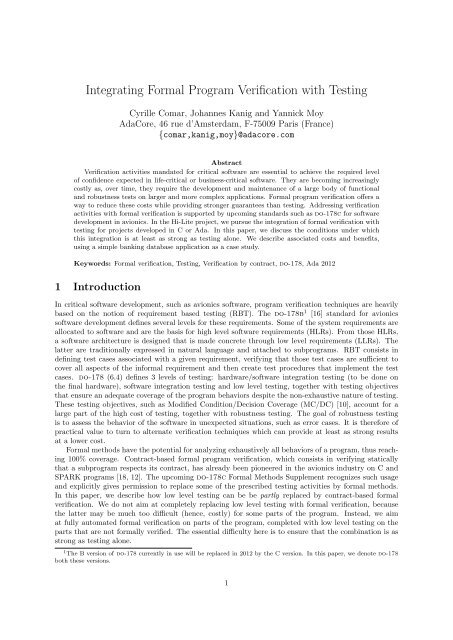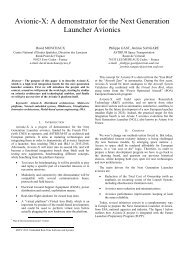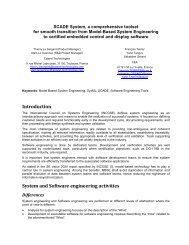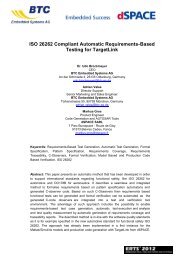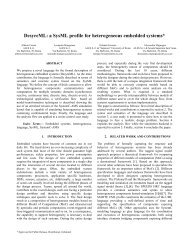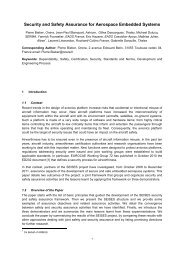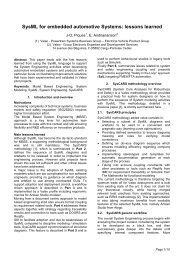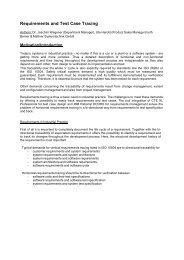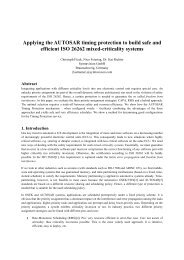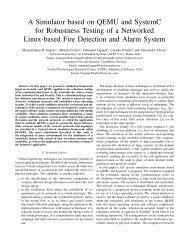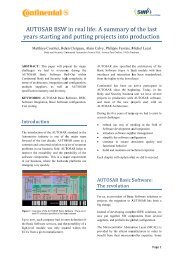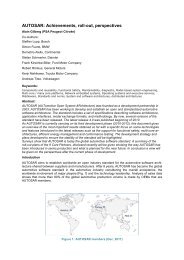Integrating Formal Program Verification with Testing
Integrating Formal Program Verification with Testing
Integrating Formal Program Verification with Testing
- No tags were found...
You also want an ePaper? Increase the reach of your titles
YUMPU automatically turns print PDFs into web optimized ePapers that Google loves.
1.3 Combining <strong>Testing</strong> and <strong>Formal</strong> <strong>Verification</strong>While formal verification gives stronger guarantees than testing, these guarantees depend upon theassumptions described in Sections 1.1 and 1.2. In a context where all subprograms are formally verified,these assumptions are met automatically. They are either discharged by meta-level reasoning, staticanalysis or proof. One of the keys to combining testing and formal verification is the ability to verifythese assumptions on the parts of the code that are not formally verified. Whether the combinationhappens at the subprogram level or at a larger software component level, the issues are the same:assumptions on properties of other parts of the code are made, and those assumptions must be verified.There are several ways of combining testing and formal verification. The simpler case (denoted heret+f.1) is to divide the application into chunks (e.g., subprograms) and apply completely one of theverification methods for each chunk. Another possibility (denoted t+f.2) is to verify each separate LLR<strong>with</strong> a given verification method. Thus, when a subprogram implements several LLRs, it should bepossible to apply both techniques for partial verification of the same code. A third possibility (denotedt+f.3) is to demonstrate specific formal properties that would replace part or all of robustness testing.1.4 A Case StudyWe are currently developing two toolchains for combining testing and formal verification of programsin project Hi-Lite [2]. AdaCore is developing a toolchain for projects in Ada, based on the Ada GNATcompiler in GCC. CEA is developing a toolchain for projects in C, based on the Frama-C platform andGCC compiler. Both platforms share a common proof back-end developed by INRIA, based on theWhy3 [7] intermediate language.GNATprove [11] is our tool for contract-based formal verification of Ada subprograms. GNATprovedefines a complete proof compilation chain, from source programs in a large subset of Ada to Why3 [7],from which it generates <strong>Verification</strong> Conditions (VCs) that are proved <strong>with</strong> the Alt-Ergo automaticprover [6]. A VC is a logical formula whose validity must be proved to ensure that a correspondingassertion in the source Ada program is verified. Note that GNATprove does not verify that a subprogramterminates.In this paper, we describe the approach chosen in GNATprove. We present examples in the context ofa small case study in Ada, consisting in a simple banking database application. HLRs for this applicationare the following:1. It should be possible to open and close empty accounts attached to named individuals uniquelydetermined by an identifier (e.g., SSN, ID), to deposit and <strong>with</strong>draw money on an account, and toquery the account balance.2. There is a maximal number of 200 000 accounts that can be in use simultaneously.3. An account is in a fixed currency decided at opening. All deposits and <strong>with</strong>drawals on this accountshould be in the same currency.4. Accounts cannot hold more than 1 million, whatever the currency.5. The bank does not lend money. The balance should always be non-negative.LLRs are derived from HLRs by defining a base API for package Database consisting in five subprograms,together <strong>with</strong> a specification of their functionality:• Balance: query the current balance of an existing account.• Open: open a new account. The maximal number of accounts should not be reached already. Thenewly created account is attached to the given name and identifier, and it has a balance of zero.• Close: close an existing account attached to the given name and identifier. The balance should bezero prior to closing the account.• Deposit: deposit an amount of money on an account. The amount should be in the same currencyas the account, and after deposit the balance should not exceed 1 million.3
For example, procedure Open reads and writes four global variables: scalar First_Available andarrays Links, Accounts and Accounts_Balance; and it has one input-only parameter of scalar type Cur.Thus, for each call to Open, we must check that the following pairs of arguments and global variablesare not aliased: Customer and Account, Id and Account, and any pair of an argument in (Customer,Id, Account) and one of the global variables. Most of these pairs cannot be aliased due to the strongtyping guarantees of Alfa. Therefore, we only need to check that the argument Account and the globalvariable First_Available are not aliased. Since the only possibility of aliasing in Alfa is through namedreferences, this amounts to a simple semantic check, like done in SPARK or Why3.2.4 <strong>Verification</strong> of User-Defined ContractsFor user-defined contracts, a VC should be generated for each assertion that should hold for the sourceprogram, and given as input to an automatic prover.In our example, in the case of function Balance, there is no postcondition to prove. However, functionBalance has a precondition, which should be proved at each call to Balance. This is the case both in codeand in contracts, since even in contracts a function call must respect its precondition. For example, a VCshould be generated to show that the precondition of Balance is satisfied when called in the postconditionof Open. Here, this can be proved easily because the required property Existing (Account) is alreadyin the postcondition of Open.In the case of procedure Open, there is a postcondition to prove. So a VC should be generated toshow that, in any calling context satisfying the precondition of Open, its implementation returns in astate where the postcondition holds. Both the precondition and postcondition of Open contain callsto functions: Max_Account_Reached in the precondition, Existing, Belongs_To and Money.Is_Emptyin the postcondition. The way calls are handled in proofs is to abstract each call by the underlyingfunction contract. Here, all functions used in contracts are defined as expression functions, which can beabstracted by their implicit postcondition.GNATprove proves automatically all contracts in our example: 17 preconditions on calls and 7postconditions on subprograms.2.5 <strong>Verification</strong> of Absence of Run-Time ErrorsFor each possible run-time error that can be expressed as an assertion (i.e., all run-time errors in Alfacode except stack overflow), a VC should be generated and given to an automatic prover.Like code, contracts can raise run-time errors since they are executable. Hence, VCs should begenerated and proved for possible run-time errors in contracts. Preconditions deserve a special treatmentas it is not known in general in which context the subprogram may be called. In order to completelyrule out run-time errors in preconditions too, preconditions should be self-guarded, so that no run-timeerrors can be raised in any context.In our example, the implementations of function Balance and procedure Open may raise exceptionsfor range checks on scalar subtypes and index checks on array accesses. In both subprograms, the preconditionand the postcondition cannot raise a run-time error (or only inside a call, but the correspondingfunctions are also formally verified.)GNATprove proves automatically all run-time checks in our example: 32 index checks, 16 rangechecks and 10 overflow checks.2.6 Consistency ChecksLike code, contracts are written by humans and thus can contain errors. We have devised various waysin which we could detect inconsistencies in contracts, in order to catch errors as early as possible, evenbefore an implementation is available. In each case, it consists in generating specific VCs for additionalchecks: redundant annotations, inconsistent annotations and unimplementable contracts.• A redundant annotation is the repetition of a known fact, which may not be obvious to the user.Yet, it can be shown also in a simple example:Pre => Existing ( Account ) and then not Is_Available ( Account ) ;6
Here, since Existing is defined as the opposite of Is_Available, the precondition above is redundant.• An inconsistent annotation is an annotation that can never be satisfied, which again may not beobvious to the user. Using the same example as above, a simple example of inconsistency is:Pre => Existing ( Account ) and then Is_Available ( Account ) ;• An unimplementable contract has the following characteristic: there are values of variables onentry to the subprogram, such that the precondition holds, for which no values of variables on exitfrom the subprogram satisfy the postcondition. In other words, no implementation can respect thecontract. It is not always obvious how to detect unimplementable contracts by review as shown bythe following contract:function Sign (X : Integer ) return Integer <strong>with</strong>Post => ( i f X = 0 then Sign ’ Result = 1) ;Here, there is a problem for X = 0, because it will be impossible to find a result that is both equalto -1 and 1 at the same time.Note that the VCs generated for consistency checks are not related to the verification of contractsor absence of run-time errors. We are only interested in the possibility of proving (or disproving) someof them, not all of them. The VCs proved (or disproved) will pinpoint redundant, or inconsistent,or unimplementable contracts, but we are not aiming at proving that a contract is not redundant, orconsistent, or implementable.3 Mixed <strong>Verification</strong>We wish to apply formal verification as broadly as possible, to Ada programs containing subprogramsin Alfa and subprograms not in Alfa (because they are using pointers, exceptions, etc.). We are interestedin a methodology that allows applying formal verification to subprograms in Alfa, and testing tosubprograms not in Alfa. Clearly, the results of the combination cannot be as strong as those providedby complete formal verification. Instead, we aim at a combination whose results are at least as strong asthose of testing alone. This allows replacement of testing by formal verification for subprograms in Alfa.3.1 Language RestrictionsWe must restrict the language used for the complete program, in order to be able to discharge on thetesting side the assumptions made by formal verification. Still, we want to allow exceptions and pointers,that are not allowed in Alfa.Data dependencies are transitive. In order to compute accurately data dependencies of Alfa subprogramssubject to formal verification, we need to compute them as well on all Alfa Friendly subprogramsthat are called from Alfa subprograms. In order to guarantee the correctness of computed data dependencies,we distinguish between those global variables that cannot be pointed to, and those globalvariables that can. The former are the only global variables that are allowed in Alfa. The latter arecollectively referred to as a single logic variable Heap, which represents all locations reachable indirectly.We also forbid calls through subprogram pointers, whose data dependencies are not easily computable,and controlled types, whose finalization requires the insertion of calls at many different places in thecall-graph, thus complicating the computation of data dependencies.The restrictions above are enough to guarantee that aliasing can be detected when it might invalidateassumptions made by formal proofs. In particular, by forbidding calls through subprogram pointers,we know statically for each call which subprogram is called, and its data dependencies. This allowsperforming a global static analysis to detect aliasing between call arguments and global variables in datadependencies.The above restrictions define the Alfa Friendly subset of Ada 2012. They guarantee that implicitcontracts for data dependencies, strong typing and non-aliasing can be verified. <strong>Formal</strong> definitions of7
aliasing. For the aliasing to occur in the second case, similarly, a part of Heap must have been passedexplicitly in an argument to a function call which has Heap in its data dependencies. We also staticallyreject such calls. For procedure Open, this amounts to rejecting all calls which pass the global variableFirst_Available as argument Account.In practice, we will define a special mode of the GNAT compiler, so that additional assertions areinserted in the executable to perform the run-time checks described above.3.4 <strong>Formal</strong> Test CasesIn general, testing a subprogram is performed <strong>with</strong> manually coded oracles which translate the LLRsfor the subprogram into code. If these oracles are coded as assertions, then they can also be coded asa subprogram contract. Then, testing the subprogram reduces to calling it on suitable inputs, sincecompiling the code in the appropriate mode already inserts assertions for contracts in the executable.A contract describes the overall expected behavior of a subprogram in an expected context. Whenverification is based on testing, we recommend exercising the subprogram on representative inputs that“cover” the input space. In other words, there must be enough test cases in order to functionally coverthe LLR. Furthermore, since testing is non exhaustive, it may be the case that the subprogram can becalled in an unexpected context, for which a desired outcome should be specified in order to make thecode robust to such unexpected situations. do-178 differentiates these two kinds of test cases:• the normal range test cases, that verify the subprogram <strong>with</strong> respect to its requirement, and• the robustness test cases, that verify the behavior of the subprogram in abnormal circumstances.In many cases, these test cases can be expressed as additional contracts that a subprogram shouldrespect. Using the permission in Ada 2012 to create compiler-dependent aspects, we have defined inthe GNAT compiler a new Test_Case aspect that allows users to describe test cases in subprogramspecifications, along <strong>with</strong> contracts. A test case is either in nominal mode (to test in an expected callingcontext) or robustness mode (to test in an unexpected calling context). A nominal test case may refine thesubprogram contract by defining a requires-clause (added to precondition) and an ensures-clause (addedto postcondition). A robustness test case replaces the subprogram contract <strong>with</strong> its requires-clause andensures-clause so that the program can be exercised outside of the range of its contract.For example, two test cases can be defined for function Balance as follows:function Balance ( Account : in Account_Num ) return Money . Amount<strong>with</strong>Pre => Existing ( Account ),Test Case => ( Name => " existing account ",Mode => Nominal ,Ensures =>Balance ’ Result . Currency = Currency ( Account )),Test Case => ( Name => " unknown account ",Mode => Robustness ,Requires => not Existing ( Account ),Ensures => Balance ’ Result . Currency = None ) ;The test case “existing account” exercises the nominal mode of function Balance, in which its contractshould be respected. Here, we want to test additionally that the currency of the result is the same asthe currency of the account. The test case “unknown account” exercises function Balance outside itsnominal mode. Here, we ignore the contract of Balance. Instead, we require that the Balance be calledin a context where the input account does not exist, and that the result is in a default invalid currency.The definition of formal test cases allows automating the verification of functional coverage of thesubprogram contract (i.e., its requirement) by its test cases. We have developed a tool called GNATtestfor unit testing, based on the xUnit family of testing frameworks [5]. It supports Ada subprogramsspecified <strong>with</strong> formal contracts and formal test cases. GNATtest generates a test harness for a project,<strong>with</strong> a separate test procedure for each test case, or a single test procedure for a subprogram when notest case is defined. The user only has to fill each of these procedures <strong>with</strong> a proper call sequence toto the subprogram under test, then simply compile and run the test harness, to get a report detailingwhich test cases and contracts are adequately tested.9
4 ConclusionAdvances in state-of-the-art automatic provers make it possible to get strong static guarantees aboutprograms in a cost-effective way. In order to integrate such formal verification activities into the usualverification processes, it is necessary to combine their results <strong>with</strong> those of testing. This is what projectHi-Lite achieves, as exemplified throughout the paper on a simple banking database application. Themain cost incurred to apply contract-based formal verification is to formalize the properties of interestas contracts at the subprogram level, which is also a known benefit by itself: formal specifications leadto fewer defects even when no analysis is applied. The main benefits are the many different analysesthat can be performed from contracts: testing, proof of absence of run-time errors, proof of contracts,and rich consistency checks on contracts even before the code is developed.This paper presented the combination of results for subprograms that are either completely formallyverified or completely tested, which we called t+f.1 in introduction. We showed that this combinationis as strong as testing alone, provided that the code of the complete program follows some restrictions,and that additional run-time checks are executed during testing. Industrial case studies based on thetools described in this paper have started, and are expected to be completed by 2013.We foresee an interest in combining formal verification and testing at a finer-grain level. First,we could use formal verification to prove that formal test cases completely cover all aspects of therequirement expressed as a contract. As an example, consider the two test cases of the subprogram Openin our database example:Test Case => ( . . .Requires => Num_Accounts = 0,. . . ),Test Case => ( . . .Requires => Num_Accounts > 0,. . . ),Here we clearly see that the two test cases partition the input space of Open in two disjoint spaces, andcover it completely, as Num_Accounts is defined as a natural number. This can be expressed as a logicformula: the Requires of all test cases, or’ed together, should be equivalent to the precondition.Second, test cases may be useful in partitioning the formal verification of a subprogram. If thecomplete formal verification of subprogram Open turns out to be too difficult, we could at least try toprove the contract in some of the test cases, instead of the general case. This combination of formalverification and testing at the test case level, which we called t+f.2 in introduction, would require a newway to show some level of completeness of the requirement based verification. The completeness providedby coverage analysis, which is required when testing is used alone, is not applicable to a combination oftesting and formal verification on the same subprogram.Third, contracts can in some cases be completed to reflect the expected behavior in abnormal contexts.By proving these contracts, one fulfills the objectives of robustness testing, which we called t+f.3 inintroduction. Another way of addressing robustness <strong>with</strong> formal verification would be to prove formallythat the precondition is satisfied in all calling contexts. It is yet to be determined if all callers should bethen formally verified, or if a subset of these proofs would be sufficient.Acknowledgement We are grateful to the anonymous referees for their useful comments, to RobertDewar and Jérôme Guitton for discussions which helped shape this paper, and to Ben Brosgol for hisdetailed review of the manuscript.References[1] http://www.open-do.org/projects/hi-lite/a-database-example/.[2] Hi-Lite: Simplifying the use of formal methods. http://www.open-do.org/projects/hi-lite/.[3] Alfa Reference Manual. Technical report, 2011. http://www.open-do.org/wp-content/uploads/2011/12/alfa_rm.pdf.10
[4] J. Barnes. High Integrity Software: The SPARK Approach to Safety and Security. Addison-WesleyLongman Publishing Co., Inc., Boston, MA, USA, 2003.[5] K. Beck. Simple Smalltalk testing: With patterns. Smalltalk report, Oct. 1994. http://www.xprogramming.com/testfram.htm.[6] F. Bobot, S. Conchon, E. Contejean, and S. Lescuyer. Implementing polymorphism in SMT solvers.In SMT’08, volume 367 of ACM ICPS, pages 1–5, 2008.[7] F. Bobot, J.-C. Filliâtre, A. Paskevich, and C. Marché. Why3: Shepherd your herd of provers. InProceedings of Boogie 2011, the 1st International Workshop on Intermediate Language <strong>Verification</strong>,Aug. 2011.[8] L. Burdy, Y. Cheon, D. R. Cok, M. D. Ernst, J. R. Kiniry, G. T. Leavens, K. R. M. Leino, andE. Poll. An overview of JML tools and applications. Int. J. Softw. Tools Technol. Transf., 7:212–232,June 2005.[9] P. Chalin. Engineering a sound assertion semantics for the verifying compiler. IEEE Trans. Softw.Eng., 36:275–287, March 2010.[10] J. J. Chilenski. An Investigation of Three Forms of the Modified Condition/Decision Coverage(MCDC) Criterion. Technical Report DOT/FAA/AR-01/18, Apr. 2001.[11] J. Guitton, J. Kanig, and Y. Moy. Why Hi-Lite Ada? In Proceedings of Boogie 2011, the 1stInternational Workshop on Intermediate Language <strong>Verification</strong>, Aug. 2011.[12] A. Hall and R. Chapman. Correctness by construction: Developing a commercial secure system.IEEE Software, 19(1):18–25, 2002.[13] J. Hatcliff, G. T. Leavens, K. R. M. Leino, P. Müller, and M. Parkinson. Behavioral interfacespecification languages. technical report CS-TR-09-01a, University of Central Florida, School ofEECS, 2009.[14] C. A. R. Hoare. An axiomatic basis for computer programming. Commun. ACM, 12:576–580,October 1969.[15] B. Meyer. Object-Oriented Software Construction. Prentice-Hall, Inc., Upper Saddle River, NJ,USA, 1st edition, 1988.[16] RTCA. Software considerations in airborne systems and equipment certification. Document RTCADO-178B, 1992.[17] E. Schonberg. Towards Ada 2012: an interim report. In Proceedings of the ACM SIGAda annualinternational conference on SIGAda, SIGAda ’10, pages 63–70, New York, NY, USA, 2010. ACM.[18] J. Souyris, V. Wiels, D. Delmas, and H. Delseny. <strong>Formal</strong> verification of avionics software products.In Proceedings of the 2nd World Congress on <strong>Formal</strong> Methods, FM ’09, pages 532–546, Berlin,Heidelberg, 2009. Springer-Verlag.11


